|
This section contains 468 words (approx. 2 pages at 300 words per page) |

|
Caravaggio's "Calling of Saint Matthew"
Michelangelo Merisi (1571-1610), known as Caravaggio after his birthplace in Northern Italy, introduced intense new realism and a dramatic use of light and gesture to Italian Baroque art. After his arrival in Rome in 1592, Caravaggio painted for a small circle of sophisticated patrons. His subjects from the 1590s include still lifes and scenes featuring fortune tellers, cardsharpers, and street urchins dressed as musicians or mythological figures. Most of his commissions after 1600 were for religious art, and reactions to these paintings were mixed. On occasion his powerful, sometimes brutal, naturalism was rejected by patrons as unsuitable to the subject's dignity. However, this very realism was closely allied with Counter Reformation ideas of spirituality, including the meditations, or Spiritual Exercises, of Saint Iganatius Loyola (1491-1556), the founder of the Jesuit order. It was also connected to the populist theology of the preacher Filippi Neri, later called Saint Philip Neri (1515-...
|
This section contains 468 words (approx. 2 pages at 300 words per page) |

|


